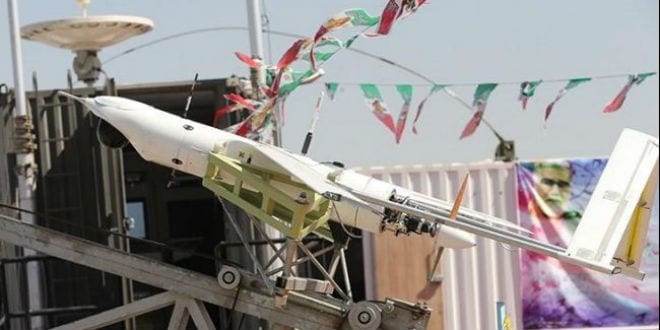The US House of Representatives voted last week to pass the Stop Iranian Drones Act.
“It shall be the policy of the United States to prevent Iran and Iranian-aligned terrorist and militia groups from acquiring unmanned aerial vehicles, including commercially available component parts, that can be used in attacks against United States persons and partner nations,” the bill says.
The move was an important step in highlighting the increased Iranian drone threat to the region. It is also important because the bipartisan legislation was sponsored by Reps. Michael McCaul (R-Texas), Gregory Meeks (D-New York), Ted Deutch (D-Florida) and Joe Wilson (R-South Carolina). US lawmakers are beginning to understand how drones, and various versions of what are called UAVs and unmanned aerial systems (UAS), are playing an emerging role in the Middle East.
Iran got its start in drone warfare relatively early, back in the mid-1980s. The country had recently gone through the Islamic Revolution of 1979 and was fighting a vicious war against Iraq. Iraq had a plethora of military equipment, especially Soviet arms. Iran, by contrast, was stuck with American military supplies left over from the shah’s era. Without spare parts, it couldn’t fight the war without mass human wave attacks and high casualties. Some Iranians understood that drones, which Israel had used with effect against Syrian air defenses in 1982, were the wave of the future. In those days drones resembled large model airplanes, operated by remote control. In Iran’s hands the drones were used to do surveillance of the front.
Fast-forward 20 years to the 2000s and we find Iran beginning to build larger, more sophisticated drones. These were often modeled on captured drones or blueprints of foreign UAVs. This included Iran’s attempt to copy the American Predator and secretive Sentinel drone. Iran’s copies were slower, had less of a range and had worse cameras than the US models. But Iran was showing that, despite sanctions, it had success with these futuristic weapons.
Iran’s investment in drones in the last decade appears to be an outcome of the Iran deal and the US decision to leave that deal. In 2015 Iran’s regime believed that, through sanctions relief, it might get access to trade and more advanced weapons and hi-tech from abroad. However, it soon realized this might not happen, and the Islamic Revolutionary Guard Corps took advantage of the regime waiting for sanctions relief and the relief’s failure to materialize to showcase new drones to the ayatollah. The result was that the IRGC got the upper hand in an arms race and received some benefit from a window of appeasement of Iran after 2015 that enabled it to move more drones to the Houthis in Yemen and to Hezbollah. As the Syrian regime began to turn the tide in Syria, Iran also moved more drones to Syria’s T4 air base in 2017 and then to the Golan area in 2018 and 2019.
Meanwhile, in Iraq, as the pro-Iranian Shi’ite militias such as Kataib Hezbollah became empowered after the war against ISIS, they also received new drone technology. Soon the Hashd al-Sha’abi or PMU, the umbrella group that Kataib Hezbollah operates under, was using drones. Kataib Hezbollah used them to threaten Saudi Arabia and later the UAE between 2019 and 2022. These groups also began to threaten US forces in Erbil, the capital of the Kurdistan autonomous region. Iran also used drones in Syria to threaten US forces, first in 2017 and then in 2021 when it threatened the Tanf garrison of US forces that are in Syria near the Jordanian border.
What is clear is that Iran set its goal as perfecting several cheap kamikaze munitions, called “loitering munitions,” which are a combination of drone and cruise missile technology. The Houthis in Yemen turned this into the Qasef line of drones, modeled on one of Iran’s lines of Ababil drones. Hezbollah and Hamas also operated similar drones, as does the PMU in Iraq.
Soon these drones were threatening Saudi Arabia. In September 2019 Iran went one step further and carried out an attack on Saudi Arabia’s Abqaiq energy facility, using drones and cruise missiles. This lifted the veil on a new Iran strategy using kamikaze drones against sensitive infrastructure.
Iran also began to test Israel’s defenses with drones flown from Syria in February 2018, the aforementioned Hezbollah drone use near the Golan in August 2019, a drone flown from Iraq in May 2021 and other threats emanating from Iran in early 2021, as well as early 2022. This coincided with the rising Iran drone threat against US forces in Iraq in 2021 and the use of a drone against a commercial ship in July 2021.
Iran uses drones in part because this gives it a kind of instant air force, when it can’t acquire new warplanes. These cheap weapons also enable it to threaten the whole Middle East over thousands of kilometers, attacking at a place and time of its choosing. It can base drones, such as the V-shaped Shahed 136, in places like Yemen and threaten Israel without even needing to use the drones. Drones also let Iran empower proxies and partners such as Hezbollah and Hamas.
When Iran moves the technology to these groups, it can deny that it is behind the drone attacks. Furthermore, drone attacks enable Iran to not risk its own soldiers, and it can claim plausible deniability when its drones slam into ships or other places.
When Iran uses drones, if there are no casualties, the country being attacked can also refrain from retaliating, meaning the use of drones sometimes means less urgency for countries to go to war.
This new drone war has been on display, with Hezbollah using drones to try to penetrate Israel’s airspace as well. Hezbollah wants a propaganda public relations coup in these incidents. It may not even care about how well its drones perform.
While Hezbollah has a large number of drones, the real goal of Iran and its proxies may sometimes be to test Israel’s defenses, rather than use them to destroy things.
Nevertheless, the threat is rapidly rising. Hamas used new drones in the May 2021 conflict. The attacks against US forces in Iraq and Syria, and against a ship in the Gulf of Oman in July 2021, as well as reports the US downed drones over Iraq that were heading to Israel, are all examples of the rising threat.
Reprinted with author’s permission from Middle East Forum





